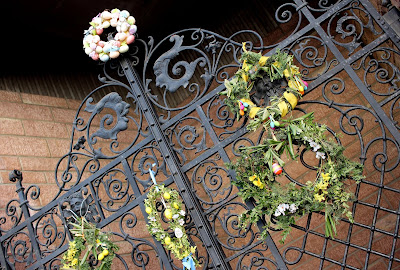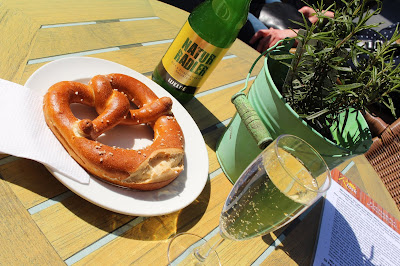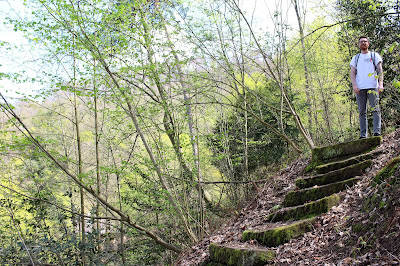Our third day and second full day in Heidelberg was all about the glorious ruined castle that proudly overlooks the quaint little city, Heidelberger Schloss, and the little mountain on which it sits, Königstuhl. The mountain is called "King's Seat" or "King's Throne" because, as you might guess based on the presence of the massive majestic castle, this used to be an important center of local rule.
The castle was first and mainly built throughout the 13th century, but it was expanded more in the 17th century and over its long history has been destroyed by lightning bolts, fire, water damage, and of course war, so it's kind of been an ongoing project, like any great structure tends to be.
Lots of expanding, connecting, accidents, and rebuilding happened until about 1650; after this point, it was just destruction and rebuilding. This turning point was during the Thirty Years' War (1618 - 1648), which was also the first time Heidelberg Castle was ever the target of attack.
During the Nine Years' War (seriously Europe, calm the fuck down) not long after, at the end of the 17th century, is when the coup de grâce was struck, and it was indeed the French who were responsible. Basically, they claimed this area, known today as the German federal state of Rheinland-Pfalz or Rhineland-Palatinate, as French, and wanted it.
In 1688, they were like, we are gonna lay waste to this whole area to prevent future attack from it mmkay, and the local ruler - I guess something like the governor - had abandoned Heidelberg, making that seem pretty easy for them at first. They occupied the area for about six months and set fire to the castle as they were leaving it in early 1689, also blowing off the front of one of the big towers.
The new governor who took control in 1690 immediately had the walls and towers rebuilt, so when the French rolled up again in '91 and '92, the town was so well-defended that they couldn't even get in. In 1693, though, their tenacity paid off. They couldn't manage to get control of the castle, at first, even after taking the city, so they burned Heidelberg, finally got to the castle, and finished what they had started a few years before, blowing much of it to smithereens with landmines.
I found this painting (Jacques Fouquier, ~1650) while looking for more info about the grounds and ruined bathhouses I was posting on Instagram, and it shows what they looked like in their prime:
Anyway, since the gentle but nonstop rain had prevented us from doing this the day before, we got up fairly early, determined to see the sites and sights, including the funicular that goes up to the castle at to the summit of Köningstuhl. I had never heard of such a thing before: a funicular is basically to a train as an inclinator is to an elevator. Neat!
When we left Hamburg (on April 12th, mind you) the trees still didn't even have leaves;
it was nice actually seeing springtime in the south for this romantic trip.
Just outside the funicular or Bergbahn ("mountain train") station I spotted these Easter wreaths on this beautiful wrought-iron gate to nowhere, long enough after Easter that it was a little surprising. You might remember that Easter was kind of a let-down for us, and that Osterbrunnen or decorated Easter fountains are really not a thing in the north, so I was satisfied to have seen at least a little snippet of the same idea. Next year!
The Bergbahn was not running up to the castle itself, so the only option was to go up the many stone stairs to reach it. It's pretty much the same as going to a temple perched on a mountainside in Japan. Hannes heard one woman, with her husband and children, bitching about it incessantly, saying things like, "They can't expect people to do this, just have the train not running!" and her husband was like "Look, if you want to see the castle up on the mountain, you have to go up the mountain! It's your choice!" Eeeesh..
The walk up was beautiful.
These are houses! Houses! People live in these!
Actually, a lot of them are historic fraternity houses, as Heidelberg houses the oldest university in Europe and much of its leading and progressive research in medicine and psychology. In Germany fraternities have become, basically, privileged alt-right incel fuckboi clubs, which is not surprising or all that different from the States, but still really sad.
I was a bit winded when we made it to the top and had to sit down for a minute before we continued. But everything is worth a pause and a look here; each wall, building, and tree is old and lovely.
The view from the main level of the castle and its grounds, where the vast lawns
and bathhouses are, is pretty glorious.
Apparently this (I mean, like, all of it) is one of the most important Renaissance structures
north of the Alps. Yes, I believe it; that checks out.
At one point Hannes said, "This is some Uncharted shit, seriously," with a big impressed smile.
I don't game but I do watch him play while doing other stuff (like this here blog post) sometimes, if they're attractive and interesting. Even if you're not into gaming either, I highly recommend watching the trailer for Uncharted 4, the one he was referring to, because the graphics are mind-blowing and it's more like an adventure movie than a game.
Check out that sundial! I'd never seen one like that before.
Randomly choosing an area to see first once we had paid admission for the interior parts of the castle, its balcony and courtyard, we found ourselves looking at a massive barrel or cask for wine. We hadn't googled anything beforehand and didn't know about this, but soon realised that we weren't even looking at the right barrel. This is the small one.
This is the famous wine barrel of Heidelberg castle, or more accurately, the third or so that I was able to get in the picture, with humans for scale.
It's housed in its own two-story room and has a capacity of over 221,000 litres, or over 58,000 gallons, and it probably goes without saying that it is the biggest wine barrel in the world. It was built in 1751 and measures about seven metres high by eight and a half metres wide. That area those people are standing on is a damn dance floor, because at this point, who cares how outrageous you are, #yolo or whatever, just put a dance floor on it.
Sadly it wasn't used for its main purpose of holding an obscene amount of wine more than a few times, but I've gotta say, those parties must've been bomb before the French landmined the shit out of the place. At least they had the good sense to leave the house-sized wine barrel intact.
This guy here is Perkeo of Heidelberg, who lived a short 33 years at the beginning of the 18th century. He was apparently a notable court jester and dwarf here, notable enough to be trusted with guarding the barrel as a commemorative statue. Over the years he's kind of become Heidelberg's unofficial mascot, along with Robert Bunsen and that creepy monkey on the bridge.
This is what I referred to as "the balcony" before, at the front of the castle.
Three versions of the same view; which do you like most? I'm partial to this one.
Here are the tracks for the Bergbahn that wasn't running; not only was it closed from the town to the castle, but it was also closed from the castle to the next stop, Molkenkur. Welp.
Time to walk up the road that winds around the mountain to take the historic old wooden train box up the slope to the summit of Köningstuhl, because the experience and the view definitely seem worth it.
Unsurprisingly, the road above the castle leading up the mountain also affords some lovely views of it, and we were the only people on the road with this vantage point; everyone was clustered at the main parts of the castle and not a single other person was making their way up as we were, even in cars. I think only one or two passed us the whole time.
One of my favourite photos I've taken of Hannes, together with that one in the forest on Rügen.
We made it to the Molenkur Bergbahn station after maybe 25 minutes up upward walking past felled trees whose sap smelled exactly like ketchup and threw back a Radler and a Sekt before boarding the creaky antique train box.
Quaint!
Cute!
Honestly it was a little nerve-wracking; the thing is pulled up the mountain by a thick steel cable ever-so-slowly, and if you watch the video clips I took of it on the way back down, you can hear each and every piece of the old wooden box straining and creaking the entire time. Even though it's built at an angle, too, it's not perfect, so that you feel like you're either leaning back or being tipped forward out of your seat. But of course, it is perfectly safe, and I definitely recommend it.
Easily one of the best photos of the trip, this grassy slope just around the corner from the Bergbahn station and its little café is a popular picnic spot because of the clear panoramic view. This kind of stuff tends to be either strictly off-limits or so packed with people and their crap that you can't even get through or see the grass in Korea and Japan; sightseeing in Germany is a really refreshing change of pace, even if people here don't know how to walk in crowds or form lines.
Clink!
A mandatory Brezel too, of course. And if you're wondering what Radler is, it's basically like half very sweet lemonade and half beer. It's amazingly refreshing and tasty, and I've insisted on having cases of it at our wedding party.
There isn't that much to do atop Köningstuhl aside from having a drink and a snack and admiring the view (we heard some people saying that over those yonder mountains was France, how lovely), and having done that, we waited for the funicular to return and slowly creak us back down to Molenkur.
It's one of those things that kind of makes you feel like you're in the past.
We decided to take the scenic trail back down instead of following the road, since we already knew where we were going and that's easier than taking it upward.
Derp
We came upon this Downtown Abbey-reminiscent house on the way down, too, or rather, the gates to its driveway. Seriously, who lives in these?!
Back down at the castle, we decided to walk around the rest of the grounds and the other area you can see in the video I took of it from our boat tour, that looks like an aqueduct from the outside.
One of the other best photos of the day for sure, this and the ones that follow were taken from that further wing of the grounds past the lawns that I was talking about.
At first I thought this was Poseidon at the entrance to the landmined bathhouse, but it's actually Vater Rhein, or Father Rhine. The river is commonly referred to as such because of how important it was for trade, commerce, and transit historically and continues to be today.
My personal favourite statue was actually this stag with the itchy foot, though.
Majestic and derpy at the same time, that's pretty much what I aim for in life.
Naturally it doesn't look like much now, unless you find cave-ins particularly interesting, but prior to being blown up by the French 400 years ago, the bathhouse contained such opulent wonders as a water organ. Like those massive pipe organs European churches have, but played with water. Amazing.
I haven't been able to identify these flowers; I've just found images of white lilacs.
Anybody?
A slight sunburn, a couple of mini-hikes, and hours of exploration later, we went back down into town and continued our last afternoon and evening in Heidelberg. The castle and funicular were impressive, wonderful, and unique, and we were really lucky to have ended up with absolutely perfect weather on that one day we did have to see it. 10/10 would recommend.


















































































